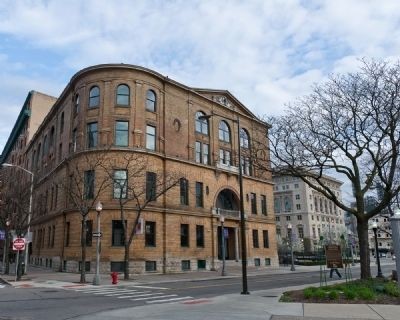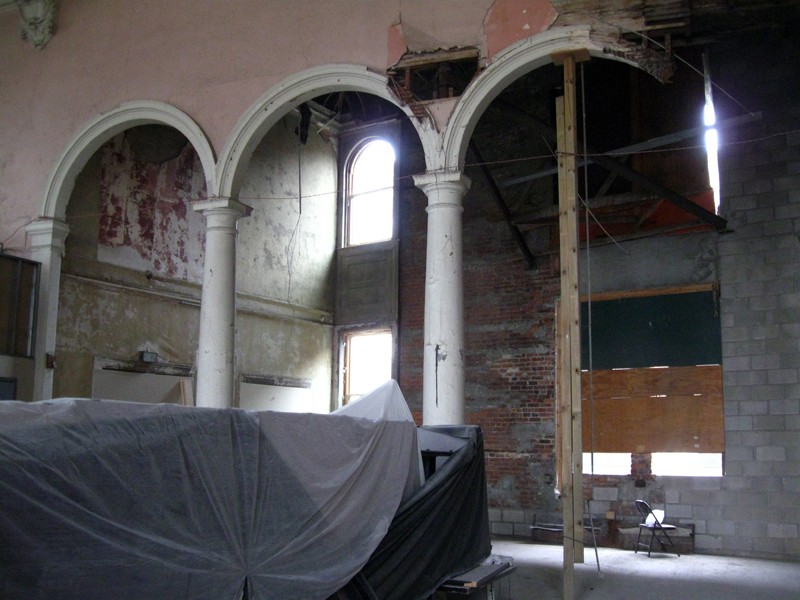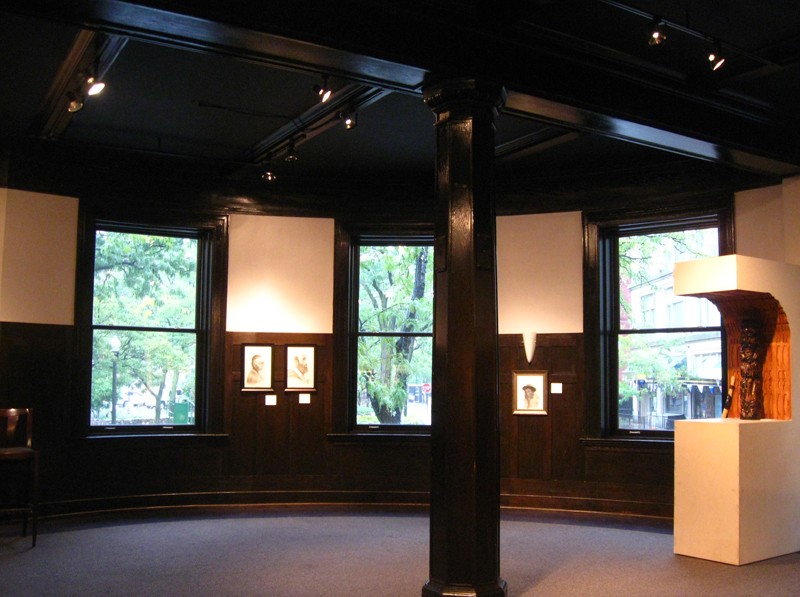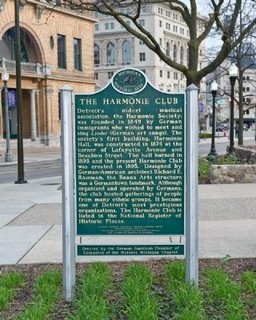Harmonie Club / The Carr Center
Introduction
Text-to-speech Audio
Images
The Harmonie Club Building (image from Historical Marker Database)

The Harmonie Club circa 1907 (image from Historical Marker Database)

The auditorium (image from Nailhed blog)

Arches in the auditorium (image from Nailhed blog)

A restored portion of the building, used as a gallery by the Michigan Arts League (image from Nailhed blog)

Restored interior (image from Nailhed blog)

Harmonie Club historic marker (image from Historical Marker Database)

Germantown historic marker at the Harmonie Club (image from Historical Marker Database)

Backstory and Context
Text-to-speech Audio
History and Future of the Harmonie Club
In the 1830s, German immigrants began arriving in Detroit and settling in the areas which are now known as Germantown and Greektown [3]. A group of ten Germans began the Harmonie Society (known originally as the Gesang-Verein Harmonie), Detroit's oldest musical club, in 1849. The group met to sing Lieder (German art songs), and was chartered in 1852. In 1874 and 1875, the club incorporated and erected their first building, Harmonie Hall, at Lafayette Avenue and Beaubien Street. The Hall, which Detroit's German community had outgrown, was lost to a fire in 1893, and an architectural competition was held for the design of the present Harmonie Club building. Only German-Americans were allowed to participate in the contest, which was won by Richard E. Raseman. Raseman's Beaux Arts building, completed in 1895, is one of Detroit's earliest and least altered examples of the style [2; 4].
The Harmonie Club building served not only as a musical center, but as the German Community's Social Club, as well [2]. The basement held the Ratskeller Pub bar and restaurant, as well as a bowling alley; the main floor held a formal lobby and dining area; the second floor was a banquet hall; and on the third floor was the Lieder Hall (Singing Hall) auditorium [5]. The Club also had card rooms, lounges, a second auditorium, and meeting rooms, and was a prominent musical and social gathering place for German-Americans (and the Detroit community in general) for decades [2; 4]. During the 1950s and 1960s, membership decreased, but minor alterations were made to the interior of the Club building [2]. In the 1970s, embezzlement by a club treasurer led to a $250,000 debt, which shut the club down. Former club president Gordon Chandler purchased the building for use as a dining club, but the business failed and the building eventually abandoned [2; 5].
In the past decade, portions of the Harmonie Club building have been restored or renovated. The basement once again serves as a lounge/restaurant, with the old bowling lanes utilized in the new lounge; the main floor is a banquet and performance area, as well as an Arts League of Michigan (ALM) gallery space; and the banquet hall on the second floor has been converted into office spaces and performance spaces for the ALM, and the conference room restored. The third floor Lieder Hall renovation is still underway [5]. Renamed the Virgil H. Carr Cultural Arts Center, the Harmonie Club building has become a new and emerging neighborhood, cultural, and entertainment hub, hosting concerts, art exhibitions, community meetings, theatrical performances, parties, visual art camps, studio spaces, and galleries [1; 6]. The Carr Center is "devoted to the preservation, presentation, promotion, and development of the African and African-American cultural arts traditions within a multicultural community," [1].
Historic Marker Inscriptions:
Harmonie Club
Detroit's oldest musical association, the Harmonie Society, was founded in 1849 by German immigrants who wished to meet and sing Lieder (German art songs). The society's first building, Harmonie Hall, was constructed in 1874 at the corner of Lafayette Avenue and Beaubien Street. The hall burned in 1893 and the present Harmonie Club was erected in 1895. Designed by German-American architect Richard E. Raseman, the Beaux Arts structure was a Germantown landmark. Although organized and operated by Germans, the club hosted gatherings of people from many ethnic groups. It became one of Detroit's most prestigious organizations. The Harmonie Club is listed in the National Register of Historic Places. / Erected 2001 by German American Chamber of Commerce of the Midwest, Michigan Chapter. (Marker Number S473.) [4]
Germantown
Fleeing political unrest in their homeland, Germans began arriving in Detroit during the 1830s. Lured by state of Michigan recruiting pamphlets, German musicians, teachers and professionals joined increasing numbers of immigrants in Detroit. By 1880, twenty percent of the city's population was German-born. Most of these immigrants settled in this area, known as Germantown, between the Jefferson and Gratiot Avenue corridors. Many opened shops and businesses ranging from breweries to tailoring shops to tanneries. Harmonie Park, its name associated with the nearby Harmonie Club, was an important center of Germantown. Greek immigrants moved into a part of Germantown that later became known as Greektown. / Erected 2001 by German American Chamber of Commerce of the Midwest, Michigan Chapter. (Marker Number 473.) [3]